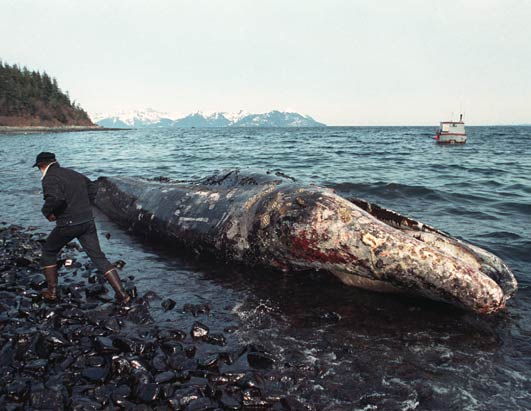20 Yrs Later- Alaskan Beaches Remain Polluted by Oil From Exxon Valdez Spill
 February 18, 2010
February 18, 2010  Kyriaki (Sandy) Venetis
Kyriaki (Sandy) Venetis  The Exxon Valdez oil spill killed tens of thousands of animals during the initial days of the disaster alone. Photo courtesy of Nature’s Crusaders.
The Exxon Valdez oil spill killed tens of thousands of animals during the initial days of the disaster alone. Photo courtesy of Nature’s Crusaders.
On Thursday evening, March 23, 1989, the Exxon Valdez, a very large crude carrier and one of Exxon’s then two largest oil tankers, left the Port of Valdez for Long Beach, Calif.
“The shipped passed through the Valdez Narrows and the pilot disembarked. Captain Joe Hazelwood ordered the vessel to procced outside the normal traffic separation lanes in order to avoid ice which had calved from the Columbia Glacier and was reported near the shipping lanes.
“The captain indicated to the mate where he wanted the vessel to turn to bring it back into the shipping lanes and then left the bridge. The ship did not make the turn prescribed by the captain, and shortly after midnight on Friday, March 24, 1989, struck Bligh Reef and fetched up hard aground.
“The grounding punctured the single-hulled vessel, resulting in the rupture of 11 of the vessel’s crude oil tanks. As a result, over 11 million gallons of crude oil were released into the pristine environment of Prince William Sound.”
This is how Craig Tillery, deputy attorney general for the Alaska Department of Law, described the events of those days to the Alaska Forum on the Environment during his keynote presentation, last February, when he brought attendees up to speed on the continuing effects of the disaster and restoration efforts.
As part of that address, he talked about the fact that about 10 years ago the Exxon Valdez Oil Spill Trustee Council noticed that “oil remained in greater quantities and at greater levels of toxicity than anyone that anticipated.”
Recent research findings from Temple University say that “it is estimated that nearly 20,000 gallons of oil remain in the beaches.”
Late last month, Nature Geoscience published the results of a three-year study by researchers from Temple University and China University of Geoscience which examined the effects of oil still remaining from the spill.

The study found that, “Patches of subsurface oil from the 1989 Exxon Valdez spill persit in gravel beaches in the Prince William Sound. The oil varies in weathering degree from slightly to heavily weathered, and contains polycyclic aromatic hydrocarbons (PAHs) known to be toxic to organisms.”
The U.S. Environmental Protection Agency has found that,”PAHs are highly potent carcinogens than can produce tumors in some organism at even a single dose. Mammals can absorb PAHs by inhalation, dermal contact or (more poorly) ingestion.”
The Temple/China University study added that, “To investigate the factors causing the subsurface oil persistence, we conducted field studies during the summers of 2007, 2008, and 2009 on six beaches. Oil tends to be more persistent on gravel beaches than on sand beaches. The smaller grains fill and accumulate downward, forming a low permeability lower layer.
“As global warming is melting the ice cover and exposing the Arctic to oil expliotation and shipping through sea routes such as the Northwest Passage, the risk of oil spills on gravel beaches in high latitude regions will be increased. Effective protection and cleanup of spilled oil in the Arctic will be challenging, considering the difficult environmental conditions and general lack of responder expertise in cold-water oil spill response. Our findings are of direct application for the susceptibility of beaches worldwide to long-term oil contamination.”
Rex W. Tillerson, chairman and chief executive officer of Exxon Mobile, said in a statement, “The Valdez oil spill was a tragic accident and one the corporation deeply regrets. We took immediate responsibility for the spill and have spent over $3.4 billion as a result of the accident, including compensatory payments, cleanup payments, settlement fees, and fines.
“The company cleaned up the spill and voluntarily compensated more than 11,000 Alaskans and businesses. The cleanup was declared complete by the state of Alaska and the U.S. Coast Guard in 1992. In the aftermath of the Valdez accident, we redoubled our longtime commitment to safeguard the environment, our employees, and the communities in which we operate.”
The Temple/China University study was funded in part by the Exxon Valdez Oil Spill Trustee Council, which contributed a $1.2 million grant.
Of the approximately $780 million of joint trust funds initially funding the council, it accounts that over $180 million has been used for research, monitoring, and general restoration. It further accounts that over $375 million has funded habitat protection, and that over $45 million has gone to annual program development, implementation, and administration.
Currently, it’s stated that approximately $76 million remains available for research, monitoring general, and restoration. In addition, the council says that $24 million remains available for habitat acquisition and protection.
The council is considering a transition to a “modest program which would focus the remaining funds on a few specific programs and habitat protection.” It has identified the following five areas to focus its remaining work:
- Herring
- Lingering oil
- Long-term monitoring of marine conditions
- Harbor protection and marine restoration
- Habitat acquisition and protection
The council began holding public meetings this week, which will run until about late March, and has opened up a comment period that will close on April 1, 2010.
More detailed information about the council’s further work on the mentioned five areas, the dates of the public meetings, and information about writing in public comments can be found on the Federal Register Notice.
Reader comments and input are always welcomed!
